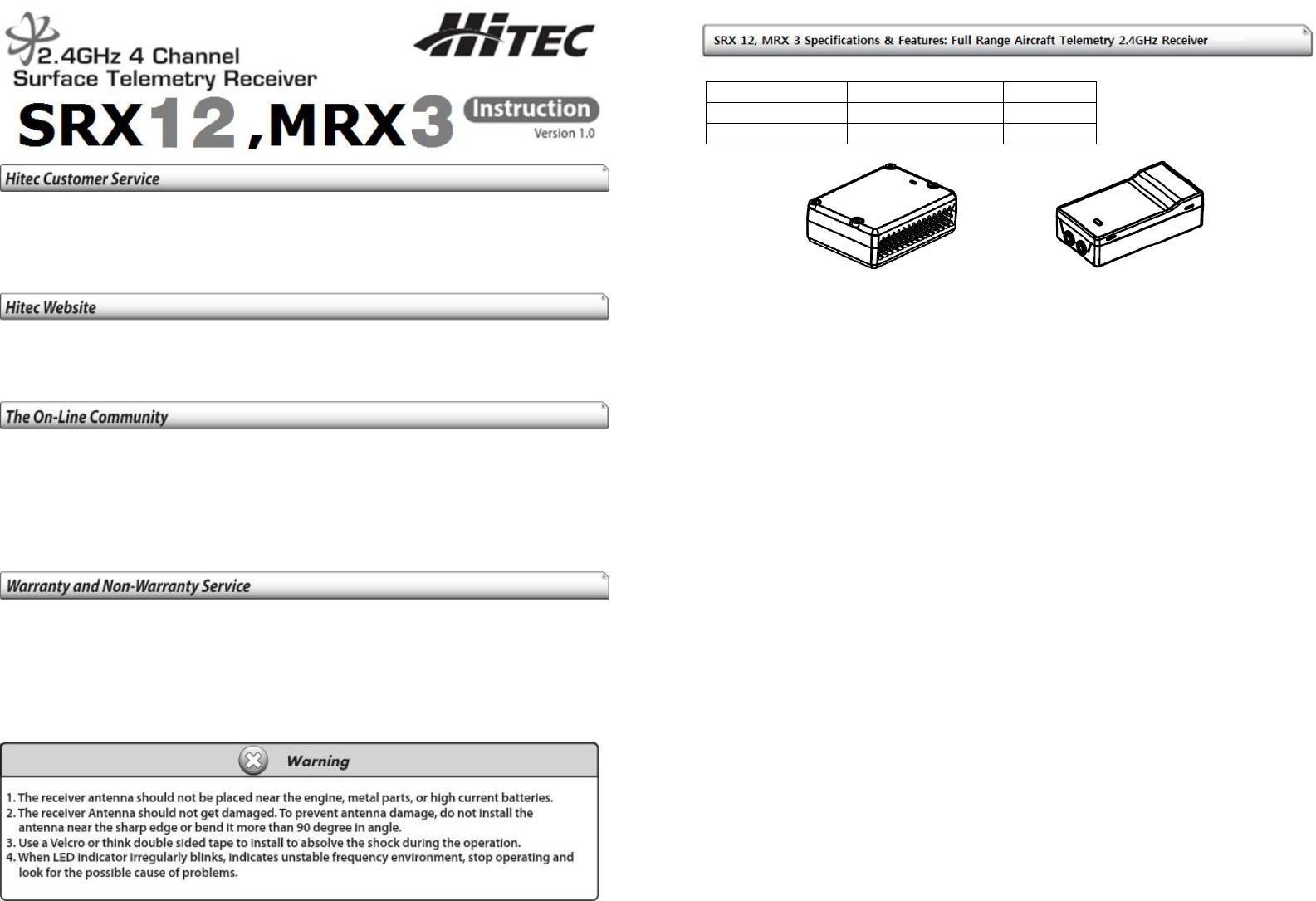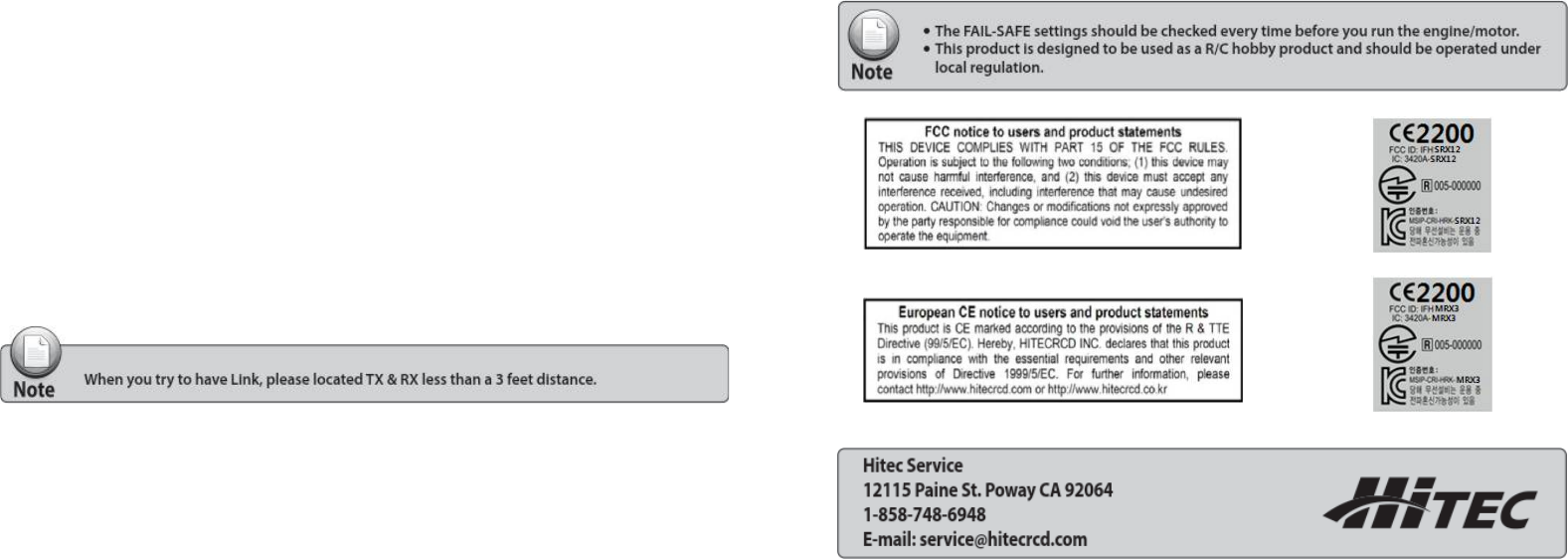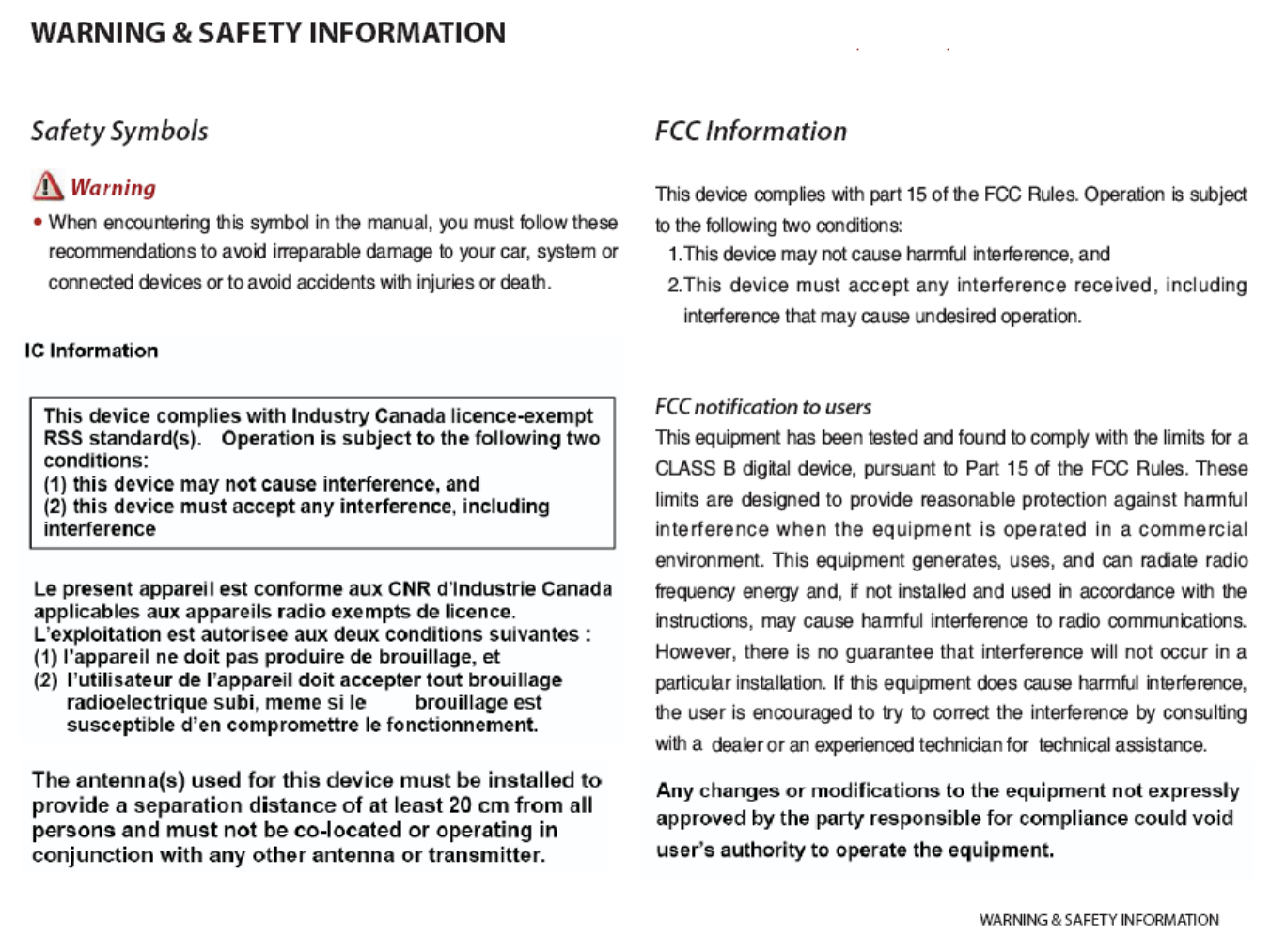Hitec RCD MRX3 2.4GHz Aircraft Receiver User Manual
Hitec RCD Inc. 2.4GHz Aircraft Receiver
User Manual

Help is available from the Hitec office through phone support and e-mail inquiries.
Our US office is generally open Monday thru Friday, 8:00AM to 4:30PM PST.
These hours and days may vary by season. Every attempt is made to answer every incoming service call.
Should you get voice mail, leave your name and number and a staff member will return your call.
Make plans to visit the Hitec website, www.hitecrcd.com, on a regular basis. Not only is it full of specs and other
informaction about the entire Hitec product line, our FAQ pages will eventually hold valuable information and
program update about the OPTIMA D receiver.
One of the bene_ts of the extensive R/C online community is the vast wealth of archived knowledge available.
Hitec sponsors forums on most of the popular R/C web sites where a Hitec staff_ member or representative tries
to answer all manner of product related questions.
Bringing together strangers with common interests is proving to be one of the greatest gifts of the internet. If
past history is any guide to the future, we are certain forums will be started about the Hitec 2.4 system and
several are certain to stand out as valuable archives of information
All Hitec products carry a two year from date of purchase warranty against manufactures defects.
Our trained and professional service representative will determine if the item will be repaired or replaced. To
provide all the necessary information we need to administrate your repair, visit our website at www.hitecrcd.com
and download the repair form, _ll it out and send in your item for repair.
Receiver Model Size Weight
SRX12 46.5 x 35.5 x 15.7mm 21g
MRX3 38.8 x 20.2 x 11.5mm 6.5g
Operation Voltage : NiMH, NiCD – 4~6 cell (4.8V~7.2V) or Li-Po – 2 cell (7.4V) can be used.Up to 7.4V BEC power
from ESC also can be used.
SRX12 SPC port allow to use up to 70V (4.8V~70.0V).
1. LED
Indicates the set-up process codes and current status of the receiver. (Please refer to page 2 for more detail)
2. System Power Input & Servo Signal Output Port
Supplying power to Receiver System, Servo, Bus system and Sensor accessories from RX Battery.
Signal output port. External Battery Voltage, SPC Input Port.
PWM Output Port
- SRX 12 – General Servo can use in CH1~CH12 Port.
- MRX 3 – General Servo can use in CH1~CH3 Port
Single Line( SL ) Output Port ( SRX 12, MRX 3 )
- With SL function, Futaba S-Bus or PPM can be selected. Please select suitable Bus system based on your
device. (Please refer to ID Link section for more detail)
Sensor Output Port *MSB* (SRX 12)
- Multiplex M-Link Sensor can be connected and can use in SRX 12 Receiver via MSB port
Voltage Sensor (MRX 3)
- MRX 3 can check External Battery voltage (Main Battery) using Voltage Sensor port up to 70V
( 4.8V~70V ). Voltage can be checked by Transmitter in real time.
SPC Power Input Port (SRX 12)
- Using SPC, SRX 12 can be operated from 4.8V to max 70V.
- When using SPC, separate servo power must be needed.
- (4.8~7.4V, 4~5cell NiMH/NiCd battery or Li-Po 2 cell Battery)

Jumper
- The jumper is installed at the factory and is used when the receiver is powered by an electronic speed
control, a commercially available B.E.C. (battery eliminator circuit), dedicated 4.8 to 6V, NiMH battery pack
or a regulated Li-Po battery. The jumper is removed when the receiver is powered using the SPC feature
as described.
Fail-Safe / Hold ( SRX 12, MRX 3 )
- If the receiver signal somehow becomes interrupted or interference occurs, the servos will move to the
pre-set Fail-Safe point you previously stored in the Fail-Safe set-up. Make sure you set the Fail-Safe
function properly.
If Fail-Safe has not been activated, the signal will switch off after the Hold period of one second.
- In the interest of safety, we recommend that the Fail-Safe function should always be activated, and the
Fail-Safe settings should be selected so as to bring the model to a non-critical situation
Please refer to Fail-Safe/ Hold page for more detail
Compatibility
- SRX 12/ MRX 3 receivers are compatible with transmitter using Spectra G3 AFHSS 2.4Ghz system. Currently
Aurora 16 and Flash 14 are using Spectra G3 AFHSS 2.4Ghz system.
- Aurora 9/ 9X, Optic 5/6/6 sports, Lite 4, Flash 7/8, Eclipse 7 pro are not compatible with SRX 12, MRX 3
receiver
Connection Diagram
Electric powered aircraft with Electronic Speed Control
Use this method on electric air plane using ESC’s providing power to the receiver and servo function.
(If ESC has no BEC circuit, please use separate battery for receiver and servo)
Glow, gas or electric powered aircraft using separate a receiver battery supply
Follow below connection diagram when using a regulated Li-PO, Li-Fe (2cell) or 4~6cell Ni-MH, Ni-CD battery.
ID Link (ID-Set up)
Each radio set (using Spectra G3 system and SRX 12 or MRX 3 receiver) is already Linked from the factory. You
don’t need to ID Link when you purchased a set of radio. However, If you buy additional SRX 12 or MRX 3
receiver, you have to do ID Link with new receiver and the radio. Before ID Link, please make sure all connection
correctly refer to above connection diagram.
How to ID Link between G3 Spectra radio and SRX 12/MRX 3 receiver
1) Turn on the Radio power
2) Select ‘Spectra’ in the system menu in the radio. (Aurora 16/Flash 14)
3) Select G3 and choose Frame Time Receiver No (S1) Bus type step by step.
4) Make sure distance between radio and receiver within 3 feet and turn on Receiver power.
5) Blue LED in the receiver will be blinking rapidly and will be blinking slowly.
6) Please check ID Link correctly or not by moving radio stick and press ‘Finish’ in the menu to escape.
Fail-Safe / Hold Function Mode
Fail-Safe Mode?
- If the receiver signal somehow becomes interrupted or interference occurs, the servos will move to the
pre-set Fail-Safe point you previously stored in the Fail-Safe set-up. Make sure you set the Fail-Safe
function properly.
If Fail-Safe has not been activated, the signal will switch off after the Hold period of one second. This
means that the servos become “soft” and remain in their last commanded position under no load (this
may equate to full-throttle!), until a valid signal is picked up again.
- In the interest of safety, we recommend that the Fail-Safe function should always be activated, and the
Fail-Safe settings should be selected so as to bring the model to a non-critical situation (e.g. motor idle
/electric motor OFF, control surfaces neutral, airbrakes extended, aero-tow release open, etc.).
1) Switch on the Radio
2) Select ‘Fail-Safe’ from system menu in Aurora 16/Flash 14
3) Select Fail-Safe or Hold for your purpose
4) If you choose ‘Fail-Safe’, set the Fail-Safe position of servo or motor by change value in the menu or stick
and then press ‘Set’ to confirm.
5) Press ‘Send’ to memorize Fail-Safe value to Receiver. (LED in the receiver will be blinking rapidly)
